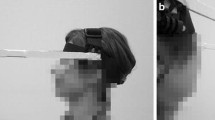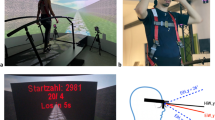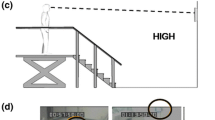Abstract
We have previously shown that participants who step in place while viewing a moving scene that simulates walking towards and turning a corner demonstrate anticipatory sequential reorientation of axial body segments with timing characteristics similar to those seen during real turning. We propose that the coordination of axial body segments during steering represents a robust pre-programmed postural synergy triggered by gaze realignment in the desired direction of travel. The primary aim of the current study was to test this hypothesis by studying the effects of constraining eye movement on visually evoked steering responses exhibited by participants stepping in place in a virtual environment. We predicted that preventing participants from generating anticipatory gaze shifts would significantly attenuate or eliminate visually evoked postural responses. A secondary aim was to investigate the nature of the visual cues that trigger the coordinated eye and whole body response by testing whether spatial (distance from the corner) or temporal (time to contact with corner) parameters modulated with the speed of the visual scene (normal, half speed and double speed). Six university graduate student (27.8 ± 5.0 years) participants were asked to step in place at a self-selected comfortable pace while immersed in a virtual environment which simulated walking down a hallway and turning a corner. In half of the trials participants were required to maintain gaze direction on a static target placed in the middle of the viewing screen. Whole body kinematics and gaze behaviour were recorded. In support of our hypothesis, gaze fixation on a stationary target resulted in the suppression of anticipatory steering responses. Although postural adjustments were still observed during constrained gaze trials, they were reactive rather than anticipatory in nature and were significantly smaller than trials in which gaze was unconstrained. Our results further suggest that the time of eye and body reorientation is dependent on the temporal rather than spatial visual cues, i.e. visually specified estimation time to contact with the virtual corner. These results indicate that gaze redirection is a prerequisite for the initiation of a pre-programmed steering synergy and suggest that these robust postural responses are intimately linked to the oculomotor control processes within the central nervous system.







Similar content being viewed by others
References
Anastasopoulos D, Ziavra N, Hollands M, Bronstein A (2009) Gaze displacement and inter-segmental coordination during large whole body voluntary rotations. Exp Brain Res 193(3):323–336
Field DT, Wilkie RM, Wann JP (2007) Neural Systems in the visual control of steering. J Neurosci 27(30):8002–8010
Golding JF (1998) Motion sickness susceptibility questionnaire revised and its relationship to other forms of sickness. Brain Res Bull 47:507–516
Grasso R, Glasauer S, Takei Y, Berthoz A (1996) The predictive brain: anticipatory control of head direction for the steering of locomotion. NeuroReport 7:1170–1174
Grasso R, Prevost P, Ivanenko Y, Berthoz A (1998) Eye-head coordination for the steering of locomotion in humans: an anticipatory synergy. Neurosci Lett 253:115–118
Grasso R, Ivanenko YP, McIntyre J, Viaud-Delmon I, Berthoz A (2000) Spatial, not temporal cues drive predictive orienting movements during navigation: a virtual reality study. NeuroReport 11(4):775–778
Hikosaka O, Takikawa Y, Kawagoe R (2000) Role of the basal ganglia in the control of purposive saccadic eye movements. Physiol Rev 80:953–978
Hollands MA, Sorenson KL, Patla AE (2001) Effects of head immobilization on the coordination and control of head and body reorientation and translation during steering. Exp Brain Res 120:223–233
Hollands MA, Patla AE, Vickers JN (2002) “Look where you’re going!”: gaze behaviour associated with maintaining and changing the direction of locomotion. Exp Brain Res 143:221–230
Hollands MA, Ziavra NV, Bronstein AM (2004) A new paradigm to investigate the roles of head and eye movements in the coordination of whole body movements. Exp Brain Res 154:261–266
Hong M, Perlmutter JS, Earhart GM (2008) A kinematic and electromyographic analysis of turning in people with Parkinson disease. Neurorehabil Neural Repair [Epub ahead of print]
Horak FB, Nashner LM (1986) Central programming of postural control movements: adaptation to altered support-surface configurations. J Neurosci 55(6):1369–1381
Lamontagne A, Fung J (2008) Gaze and postural reorientation in the control of locomotor steering after stroke. Neurorehabil Neural Repair [Epub ahead of print]
Land MF and Lee DN (1994) Where we look when we steer. Nature 30 369(6483):742–744
Latt MD, Menz HB, Fung VS, Lord SR (2008) Walking speed, cadence and step length are selected to optimize the stability of head and pelvis accelerations. Exp Brain Res 184:201–209
Patla AE, Adkin A, Ballard T (1999) Online steering: coordination and control of body center of mass, head and body reorientation. Exp Brain Res 129:629–634
Reed-Jones RJ, Vallis LA (2007) Proprioceptive deficits of the lower limb following anterior cruciate ligament deficiency affect whole body steering control. Exp Brain Res 182:249–260
Reed-Jones RJ, Hollands MA, Reed-Jones JG, Vallis LA (2009) Visually evoked whole-body turning responses during stepping in place in a virtual environment. Gait Posture Jun 25 [epub ahead of print]
Shumway-Cook A, Woollacott MH (2001) Normal control of posture. In: Motor control theory and practical applications. Lippincott Williams & Wilkins, USA, pp 163–191
Trenholme D, Smith SP (2008) Computer game engines for developing first-person virtual environments. Virtual Real 12(3):181–187
Vallis LA, McFadyen BJ (2003) Locomotor adjustments for circumvention of an obstacle in the travel path. Exp Brain Res 152:409–414
Valve Corporation (2008) www.valvesoftware.com, Accessed 9 July 2008
Wilkie RM, Wann JP (2003) Eye movements aid the control of locomotion. J Vis 3:677–684
Wilkie RM, Wann JP, Allison RS (2008) Human perception and performance. J Exp Psychol 34(5):1150–1164
Wilson M, Stephenson S, Chattington M, Marple-Horvat DE (2007) Eye movements coordinated with steering benefit performance even when vision is denied. Exp Brain Res 176:397–412
Acknowledgments
Funding for this project was provided by the NSERC PGS-D scholarship (RRJ) and the Canadian Society for Biomechanics Student Travel Award (RRJ). We would also like to thank Doerte Zietz and William Young for their help with data collection.
Author information
Authors and Affiliations
Corresponding author
Rights and permissions
About this article
Cite this article
Reed-Jones, R., Reed-Jones, J., Vallis, L.A. et al. The effects of constraining eye movements on visually evoked steering responses during walking in a virtual environment. Exp Brain Res 197, 357–367 (2009). https://doi.org/10.1007/s00221-009-1923-1
Received:
Accepted:
Published:
Issue Date:
DOI: https://doi.org/10.1007/s00221-009-1923-1




